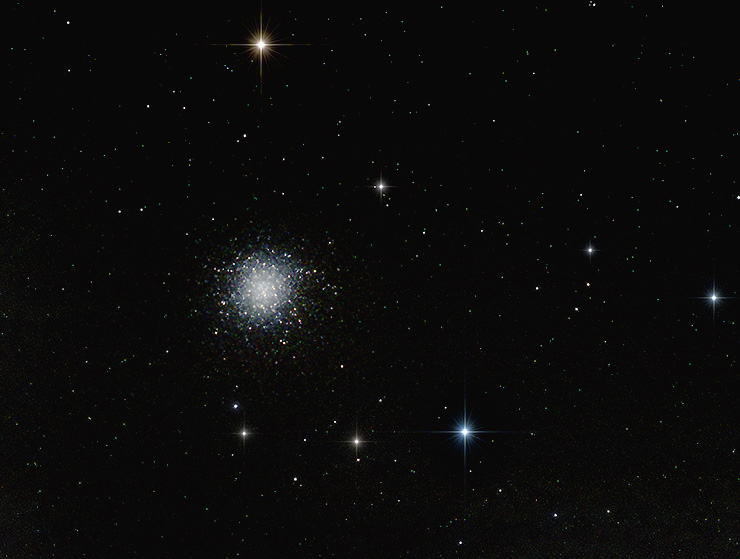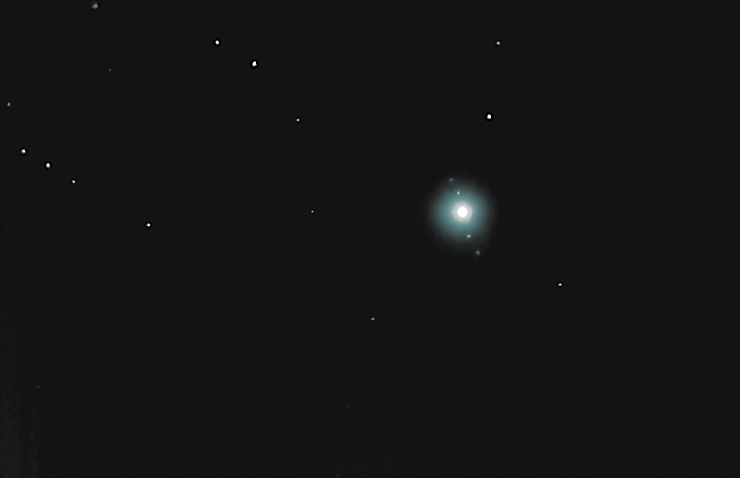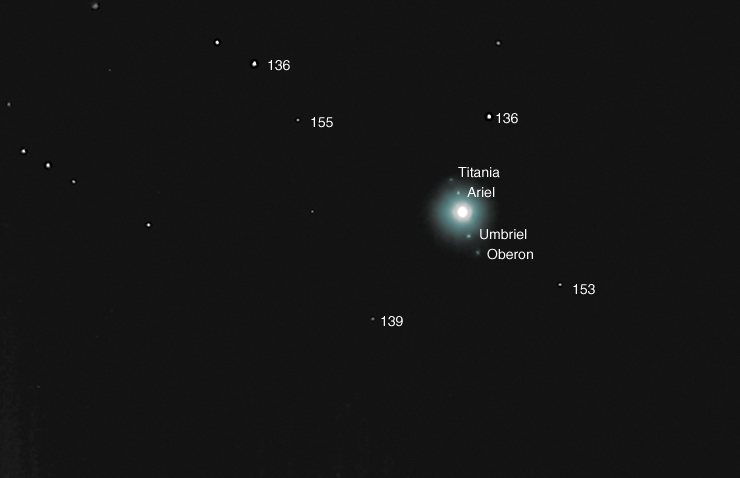|
|
9/12/2010: A few plausibility checks. After a late night at Ticknock (David Peterson and Charlie Cushman), I tried an RGB series of M13 just to make sure all the pieces are playing well together. Note that the SBIG focuses behind the diagonal with about a finger's width of the A-P focuser extended. I snagged several images with Nebulosity 2.0, adjusted polar alignment with the bore scope, and then tried again. Here's an RGB composite with Astrodon Gen-I E-series filters (yes, I know my ST2000 really wants I-series filters, but these were inexpensive and parfocal and almost color-balanced; good deal):
M13, just three, 30-second exposures,
through R, G, and B filters. More efforts to "get" this
subject appear on subsequent pages.
Then I shot a series of Jupiter to determine how much the glare of the planet might mask faint field stars and to see what exposure is required to reach what magnitude. Jupiter was quite low (25 deg or so) and the air unsteady (as a Chameleon attempt demonstrated all too clearly), but it's clear that the ST2000's clean images permit a great deal of stretching. I tried exposures from 1 ms to 90 seconds. Even under these conditions, it's pretty clear that I can reach 14th magnitude in 5s, the mid-14's in 10s. I fitted the 2x Televue barlow to the ST2000 and determined that with the barlow behind the diagonal, the telescope focuses with the focuser racked out a generous 3 inches (the CCD through a 2-inch TV Barlow is damn near parfocal with the 16mm Nagler in a 2-inch extension). Of some concern is creep in the grip rings. Think about adding a 3-point, thin adapter to the kit. In the meantime, keep the ST2000 turned to satisfy gravity in order to keep gravity's tug from rotating the CCD. (BTW, one of the thumbscrews that helps hold the cover of the polar alignment port jumped ship tonight.)
9/14-15/2010. I put an extra Barlow in the ST2000XM image train (screwed into the end of a 1.25-inch adapter which is then inserted into the Big Barlow). This gives me 508 pixels to 200 arc seconds. That's measured moon to moon across the Jovian system. The image scale works out to 0.39 arc seconds per pixel (compare with 308 pixels to 200 arc seconds, or 0.65 arc seconds per pixel, when using the big Barlow alone -- 3.9 meters EFL vs 2.35 meters). Now of course there are clouds, but they're scattered and the IR satellite view suggests that they'll blow through about the time I need clear skies. For the record, the focus with the extra Barlow is an inch or so in from the point of best focus with the 2-inch Barlow alone. I have fresh coffee. The hair drier is handy, just in case. The computer is on battery power and has been for some time. Its AC adapter is laid out if needed. Some times goes by... The image scale is excessive, at least for tonight, and at least without the Feathertouch focuser adapter. After examining and trying to work with the excessively large and unconcentrated PSF with both Barlows, I dropped back to the more modest scale of the single 2x 2-inch TeleVue Barlow. Even so, things do not seem as sharp as I would like. Also, Jupiter passed through the topmost needles of a pine tree at what would have been the most auspicious moment. I did NOT get the target of the night but the consolation prize ain't bad:
6x60s, luminance filter, SBIG ST2000XM,
What's that? Here it is, with labels:
When William Herschel discovered Uranus, he named the planet for King George III. That's George surrounded by its four brightest moons which were named for characters in Shakespeare's plays (Titania and Oberon) and in Alexander Pope's "The Rape of the Lock" (Ariel and Umbriel). Of Uranus's 27 known moons, all but three are named from Shakespeare's plays. (The naming process has been a bit more ad hoc than one might want. Wikipedia has a nice briefing.) Ad hoc or not, it's pretty stylish for a planet once called "George." Numbers are AAVSO-style magnitude labels for adjacent stars. The decimal point is omitted to avoid confusion with star images ("153" means "15.3" etc.). This field is about a fourth of the width of the Moon, and right now it's high in the southern sky before dawn. The moons are 5,000 - 10,000x fainter than the planet, and the planet is just visible to the naked eye on a sparkling night.
|
:: top ::
© 2010, David Cortner


